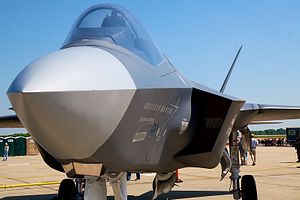At this year’s Singapore Airshow, held from February 11-16, visiting foreign defense reporters viewed a model of the Singapore Navy’s Endurance-class Landing Platform Dock (LPD) reconfigured as a Landing Helicopter Dock (LHD). This led to speculation that Singapore intends to outfit its future Endurance LHDs by procuring the Lockheed Martin F-35B Lightning IIs.
The F-35B is a fifth generation supersonic stealth fighter that meets Singapore’s unstated objective of maintaining air superiority over its immediate neighborhood. The F-35B is a short vertical take off and landing aircraft suited for Singapore’s congested landmass. Singapore is in the process of consolidating its three military airfields. The reduction in runways is compensated for by the F-35’s ability to take off in a short space. A fully loaded F-35B needs only 168 meters of runway.
In addition, the F-35B has demonstrated that it can land and take off easily from ships at sea. In recent trials, the F-35B successfully landed and took off from the USS Wasp LHD-1. The F-35B would give Singapore a winning advantage should a conflict break out in Southeast Asia.
Singapore has been a Security Cooperative Participant in the F-35 program since 2003. In 2011, Singapore began a serious study of the F-35B.
In July 2013, U.S. Air Force General Herbert Carlisle seemingly let the cat out of the bag when he disclosed that Singapore’s Chief of Defense Force, Lt. Gen. Ng Chee Meng, told him that Singapore had decided to buy the B version of the F-35. General Carlisle also indicated that the timing of Singapore’s decision to announce its procurement of the F-35B was related to its budgetary cycle.
Because Singapore is currently committed to a mid-life upgrade of its F-16s fleet, its leaders have repeatedly qualified their public interest in acquiring the F-35B. In mid-2013, for example, Lt. Gen. Ng was quoted as stating that Singapore “is in no hurry to make a decision.”
This same qualification was made by Singapore’s Defense Minister Ng Eng Hen at a joint press conference with U.S. Secretary of Defense Chuck Hagel on December 13, 2013. When asked about Singapore’s interest in the F-35B, Minister Ng replied:
I’ve said in Parliament during the last budget that Singapore is seriously looking at the F-35s to replace our F-15s. We’re in no particular hurry because our F-16s are still very operational, they are due for upgrades but it is a serious consideration and during my visit here to Luke Air Base, the US marines were kind enough to have a demonstration of the F-35Bs and it’s quite an engineering marvel. We recognise that there are aspects to consider and we will make our deliberate decision because as I said we are in no particular hurry but we are seriously considering.
Three months later, in a speech to the Committee of Supply Debate last week, Minister Ng outlined his vision of the Singapore Air Force in 2030. He noted that Singapore’s F-16s will have been upgraded with Active Electronically Scanned Array (AESA) radars and more precise air-to-ground munitions. The upgraded F-16s along with the with the F-15s will be the mainstay of Singapore’s air defense.
Minister Eg noted that by 2030 Singapore would have acquired its next generation fighter. But, he said, “We are not quite ready to decide yet, we will take our time because our F-16s and F-15s will serve us for the near term and medium term.”
Singapore would also have a more sophisticated multi-layered air defense capabilities with the deployment of the SPYDER and ASTER-30 Surface-to-Air Missile Systems.
By 2030 Singapore will have replaced its current KC-135 aerial tankers with the Airbus A330 Multi-Role Tanker Transport. The Airbus A330 can hold twenty percent more fuel than the KC-135s. The Airbus A330 will also extend the range of Singapore’s fighters through air-to-air refueling.
It is in Singapore’s interest to wait until the F-35 program develops and irons out the glitches in its software and other technical problems. The projected date for the F-35 to come on stream is around 2016 or shortly after. This would give Singapore plenty of time to evaluate the F-35Bs performance.
If Singapore acquires the F-35B it will be interoperable with F-35s flown by the United States. Other regional countries such as Japan, South Korea and Australia are likely to acquire the F-35. In sum, Singapore will be in good strategic company.

































